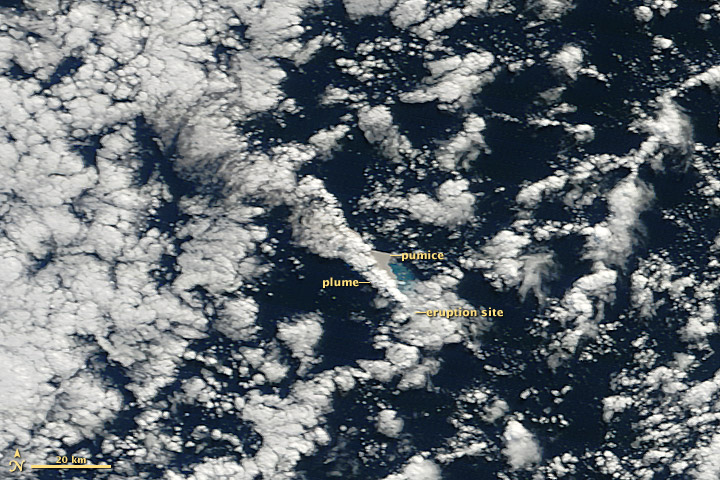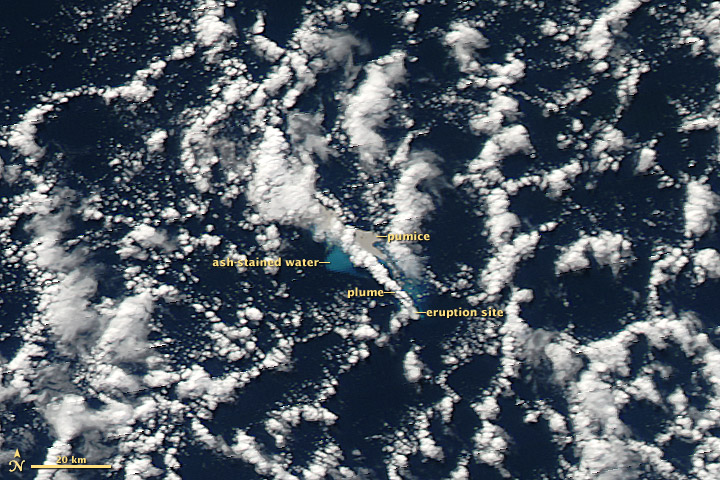
acquired July 19, 2012
download large image (1 MB, JPEG, 2048x1592)

acquired July 19, 2012
download large image (2 MB, JPEG, 2048x1592)
acquired July 19, 2012
download Google Earth file (KMZ)
Midway on its 800-kilometer (500-mile) voyage from Auckland to Raoul Island, New Zealand, the HMNZS Canterbury received an intriguing report: a maritime patrol aircraft had spotted a vast area of open ocean covered with floating pumice.
Soon after, the ship was sailing through a mass of buoyant volcanic
rocks. Up to two feet thick, the pumice raft was about half a nautical
mile (1 kilometer) wide, and “extended sideways as far as the eye could
see,” wrote Rebecca Priestley, a science writer aboard the ship. Although the lightweight, gas-filled pumice posed no threat to the Canterbury, enough got stuck in the water filters to provide samples for analysis.
Though the pumice was spread over a vast area of the South Pacific, the origin was a mystery to the crew of the ship. An undersea volcano several hundred kilometers to the north of the pumice—Monowai—had erupted on August 3, but an airline pilot reported seeing pumice as early as August 1. Two data sources provided clues to pinpoint the volcano: earthquake records and satellite imagery. After reports of the pumice rafts surfaced, scientists from Tahiti and New Zealand’s GNS Science connected the eruption with a cluster of earthquakes in the Kermadec Islands on July 17 and 18.
Working independently of GNS, volcanologist Erik Klemetti and NASA visualizer Robert Simmon examined a month’s worth of satellite imagery from NASA’s Moderate Resolution Imaging Spectroradiometer (MODIS). They discovered the first signs of the eruption—ash-stained water, gray pumice, and a volcanic plume—in imagery from 9:50 a.m. and 2:10 p.m. (local time) on July 19, 2012. (Although the Kermadec Islands are east of the International Date Line, they follow New Zealand time.)
Hidden by clouds in the morning image (above, top), the site of the eruption is clearly visible in the afternoon image (lower). Klemetti matched the satellite imagery with ocean floor bathymetry to identify Havre Seamount as the likely source. The eruption was strong enough to breach the ocean surface from a depth of 1,100 meters (3,600 feet).
Alain Bernard of the Laboratoire de Volcanologie, Université Libre de Bruxelles analyzed nighttime imagery from MODIS and found heat from the eruption at 10:50 p.m. on July 18, 2012, the earliest evidence of the Havre Seamount eruption reaching the ocean surface.
By July 21, the eruption appeared to have waned, leaving behind the dense rafts of pumice. Winds and currents spread the pumice into a series of twisted filaments, spread over an area about 450 by 250 kilometers (280 by 160 miles) as of August 13.
Though the pumice was spread over a vast area of the South Pacific, the origin was a mystery to the crew of the ship. An undersea volcano several hundred kilometers to the north of the pumice—Monowai—had erupted on August 3, but an airline pilot reported seeing pumice as early as August 1. Two data sources provided clues to pinpoint the volcano: earthquake records and satellite imagery. After reports of the pumice rafts surfaced, scientists from Tahiti and New Zealand’s GNS Science connected the eruption with a cluster of earthquakes in the Kermadec Islands on July 17 and 18.
Working independently of GNS, volcanologist Erik Klemetti and NASA visualizer Robert Simmon examined a month’s worth of satellite imagery from NASA’s Moderate Resolution Imaging Spectroradiometer (MODIS). They discovered the first signs of the eruption—ash-stained water, gray pumice, and a volcanic plume—in imagery from 9:50 a.m. and 2:10 p.m. (local time) on July 19, 2012. (Although the Kermadec Islands are east of the International Date Line, they follow New Zealand time.)
Hidden by clouds in the morning image (above, top), the site of the eruption is clearly visible in the afternoon image (lower). Klemetti matched the satellite imagery with ocean floor bathymetry to identify Havre Seamount as the likely source. The eruption was strong enough to breach the ocean surface from a depth of 1,100 meters (3,600 feet).
Alain Bernard of the Laboratoire de Volcanologie, Université Libre de Bruxelles analyzed nighttime imagery from MODIS and found heat from the eruption at 10:50 p.m. on July 18, 2012, the earliest evidence of the Havre Seamount eruption reaching the ocean surface.
By July 21, the eruption appeared to have waned, leaving behind the dense rafts of pumice. Winds and currents spread the pumice into a series of twisted filaments, spread over an area about 450 by 250 kilometers (280 by 160 miles) as of August 13.
References
- Bernard, Alain. (2012, August). Hot Spots from the July 18 Eruption in Kermadec volcanic arc. Accessed August 13, 2012.
- Klemetti, Erik. (2012, August 13). Havre Seamount: The Source of Kermadec Island Pumice Raft? Accessed August 13, 2012.
- New Zealand Defence Force (2012, August 10). Defence Force Locates 7500Sq Miles of Pumice From Underwater Volcano Accessed August 13, 2012.
- Priestley, Rebecca. (2012, August 8–11). Kermadecs voyage #2: The Mystery of the Floating Pumice. Accessed August 13, 2012.
- Radio New Zealand. (2012, August 13). Origin of Pumice Raft Found. Accessed August 13, 2012.
- Université Libre de Bruxelles. (2012, August). Hot Spots from the July 18 Eruption in Kermadec Volcanic Arc. Accessed August 13, 2012.
NASA image courtesy Jeff Schmaltz, LANCE MODIS Rapid Response Team at NASA GSFC. Caption by Robert Simmon. Detective work by Erik Klemetti.
- Instrument:
- Terra - MODIS
NASA: New Zealand - Pacific Ocean - NASA Satellites Pinpoint Volcanic Eruption - It is happening now - August 2012
Ricardo M Marcenaro - Facebook
Operative blogs of The Solitary Dog:
solitary dog sculptor:
http://byricardomarcenaro.blogspot.com
Solitary Dog Sculptor I:
http://byricardomarcenaroi.blogspot.com
Para:
comunicarse conmigo,
enviar materiales para publicar,
propuestas:
marcenaroescultor@gmail.com
For:
contact me,
submit materials for publication,
proposals:
marcenaroescultor@gmail.com
Diario La Nación
Argentina
Cuenta Comentarista en el Foro:
Capiscum
My blogs are an open house to all cultures, religions and countries. Be a follower if you like it, with this action you are building a new culture of tolerance, open mind and heart for peace, love and human respect.
Thanks :)
Mis blogs son una casa abierta a todas las culturas, religiones y países. Se un seguidor si quieres, con esta acción usted está construyendo una nueva cultura de la tolerancia, la mente y el corazón abiertos para la paz, el amor y el respeto humano.
Gracias :)

No hay comentarios:
Publicar un comentario